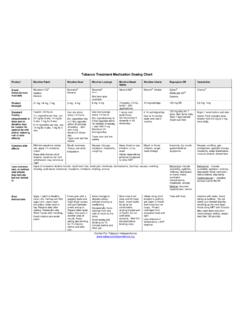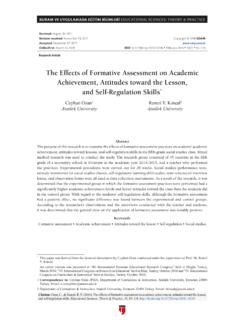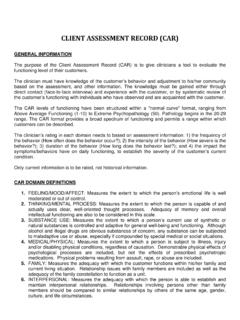Transcription of TRIAGE ASSESSMENT FORM: CRISIS INTERVENTION R.A. …
1 TRIAGE ASSESSMENT form : CRISIS INTERVENTION Myer, Williams, Ottens, & Schmidt CRISIS EVENT: Identify and describe briefly the CRISIS situation: _____ _____ AFFECTIVE DOMAIN Identify and describe briefly the affect that is present. (If more than one affect is experienced, rate with #1 being primary, #2 secondary, #3 tertiary.) ANGER/HOSTILITY: _____ _____ _____ ANXIETY/FEAR: _____ _____ _____ SADNESS/MELANCHOLY: _____ _____ Affective Severity Scale Circle the number that most closely corresponds with client s reaction to CRISIS . 1 2 3 4 5 6 7 8 9 10 No Impairment Minimal Impairment Low Impairment Moderate Impairment Marked Impairment Severe Impairment Stable mood with normal variation of affect appropriate to daily functioning.
2 Affect appropriate to situation. Brief periods during which negative mood is experienced slightly more intensely than situation warrants. Emotions are substantially under client control . Affect appropriate to situation but increasingly longer periods during which negative mood is experienced slightly more intensely than situation warrants. Client perceives emotions as being substantially under control . Affect may be incongruent with situation. Extended periods of intense negative moods. Mood is experienced noticeably more intensely than situation warrants. Liability of affect may be present.
3 Effort required to control emotions. Negative affect experienced at markedly higher level than situation warrants. Affects may be obviously incongruent with situation. Mood swings, if occurring, are pronounced. Onset of negative moods are perceived by client as not being under volitional control . Decompen-sation or depersonal-ization evident. All Rights Reserved. May not be reproduced without permission. BEHAVIORAL DOMAIN Identify and describe briefly which behavior is currently being used. (If more than one behavior is utilized, rate with #1 being primary, #2 secondary, #3 tertiary.)
4 APPROACH: _____ _____ AVOIDANCE: _____ _____ IMMOBILITY: _____ _____ Behavioral Severity Scale Circle the number that most closely corresponds with client s reaction to CRISIS . 1 2 3 4 5 6 7 8 9 10 No Impairment Minimal Impairment Low Impairment Moderate Impairment Marked Impairment Severe Impairment Coping behavior appropriate to CRISIS event. Client performs those tasks necessary for daily functioning. Occasional utilization of ineffective coping behaviors. Client performs those tasks a necessary for daily functioning, but does so with noticeable effort.
5 Occasional utilization of ineffective coping behaviors. Client neglects some tasks necessary for daily functioning is noticeably compromised. Client displays coping behaviors that may be ineffective and maladaptive. Ability to perform tasks necessary for daily functioning is noticeably compromised. Client displays coping behaviors that are likely to exacerbate CRISIS situation. Ability to perform tasks necessary for daily functioning is markedly absent. Behavior is erratic, unpredictable. Client s behaviors are harmful to self and/or others. COGNITIVE DOMAIN Identify if a transgression, threat, or loss has occurred in the following areas and describe briefly.
6 (If more than one cognitive response occurs, rate with #1 being primary, #2 secondary, #3 tertiary PHYSICAL (food, water, safety, shelter, etc.): TRANSGRESSION THREAT LOSS _____ _____ PSYCHOLOGICAL ( self -concept, emotional well being, identity, etc.): TRANSGRESSION THREAT LOSS _____ _____ SOCIAL RELATIONSHIPS (family, friends, co-workers, etc.): TRANSGRESSION THREAT LOSS _____ _____ MORAL/SPIRITUAL (personal integrity, values, belief system, etc.): TRANSGRESSION THREAT LOSS _____ _____ Cognitive Severity Scale Circle the number that most closely corresponds with client s reaction to CRISIS .)
7 1 2 3 4 5 6 7 8 9 10 No Impairment Minimal Impairment Low Impairment Moderate Impairment Marked Impairment Severe Impairment Concentration intact. Client displays normal problem-solving and decision-making abilities. Client s perception and interpretation of CRISIS event match with reality of situation. Client s thoughts may drift to CRISIS event but focus of thoughts is under volitional control . Problem-solving and decision-making abilities minimally affected. Client s perception and interpretation of CRISIS event substantially match with reality of situation.
8 Occasional disturbance of concentration. Client perceives diminished control over thoughts of CRISIS event. Client experiences recurrent difficulties with problem-solving and decision-making abilities. Client s perception and interpretation of CRISIS event my differ in some respects with reality of situation. Frequent disturbance of concentration. Intrusive thoughts of CRISIS event with limited control . Problem-solving and decision-making abilities adversely affected by obsessiveness, self -doubt, confusion. Client s perception and interpretation of CRISIS event may differ noticeably with reality of situation.
9 Client plagued by intrusiveness of thoughts regarding CRISIS event. The appropriateness of client s problem-solving and decision-making abilities likely adversely affected by obsessiveness, self -doubt, confusion. Client s perception and interpretation of CRISIS event may differ substantially with reality of situation. Gross inability to concentrate on anything except CRISIS event. Client so afflicted by obsessiveness, self -doubt, confusion that problem-solving and decision-making abilities have shut down. Client s perception and interpretation of CRISIS event may differ so substantially from reality of situation as to constitute threat to client s welfare.
10 DOMAIN SEVERITY SCALE SUMMARY Affective _____ Cognitive _____ Behavioral _____ Total _____






